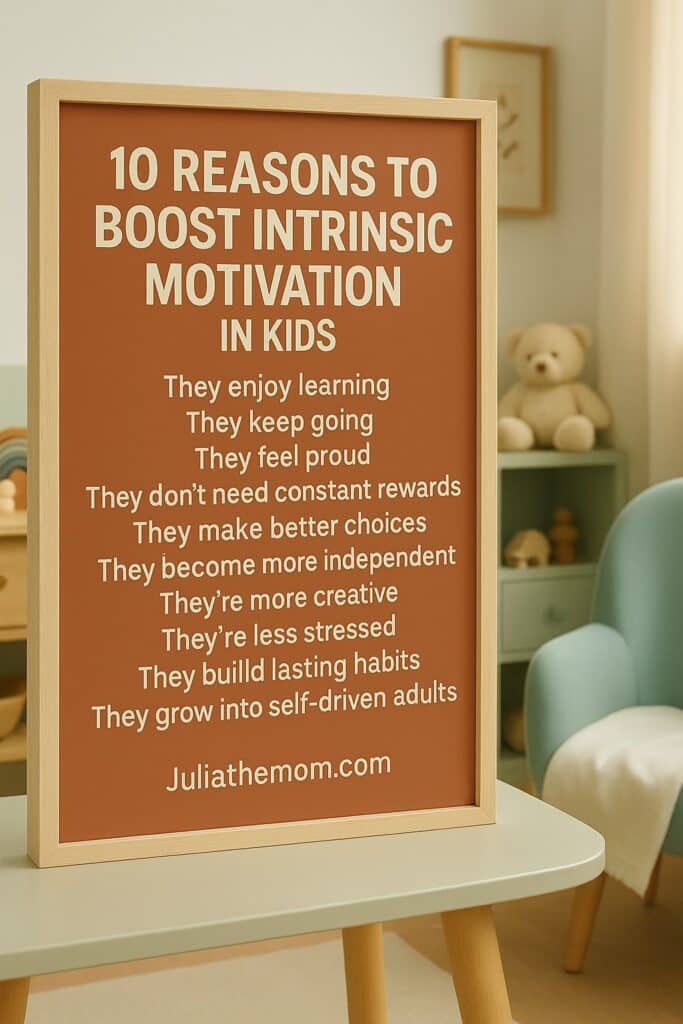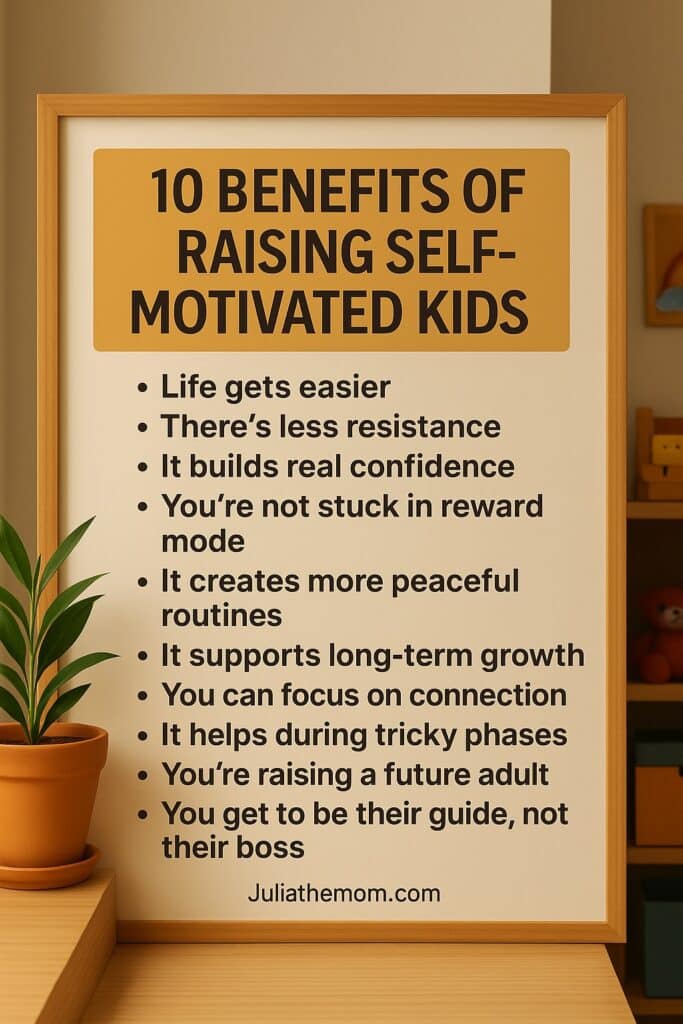Increasing Intrinsic Motivation – it’s one of those parenting goals that sounds great in theory but can get a bit messy in real life. Especially if you’re a mom with a bit of project manager brain and a slight obsession with organizing everything and keeping it all under control.
But the closer we get to the teenage years, the more I feel that my child needs something else now. So I decided to dig into this whole “improving intrinsic motivation” thing. Although, to be honest, in our case it’s probably more about how not to accidentally squash that motivation – especially when you’re a well-meaning supermom with control freak tendencies. 😅
In this post, I’ll share my first attempts at figuring it all out. Spoiler: I’m still learning, but maybe some of these insights will hit home for you too.
Table of Contents
This post may contain affiliate links, meaning I get a commission if you decide to make a purchase through my links, at no extra cost for you (full Disclaimer & Terms of Use)
External and internal motivation
Let’s start with definition of intrinsic and extrinsic motivation and then we’ll focus on the main thing – increasing Intrinsic Motivation.
As moms, we often wonder how to get our kids to actually want to do things – like homework or even practicing a hobby …or even just took the clean dishes out of the dishwasher and put them away – without a reminder – most days.
Motivation usually comes in two types: intrinsic and extrinsic. That just means your child is either doing something because they enjoy it, or because they want a reward (or to avoid getting in trouble). To be exact, extrinsic motivation comes from three main external factors: rewards, punishments, or recognition from others (thanks, Wikipedia!).
External and internal motivation examples:

- A girl is reading a book just to finish it quickly so she can go outside and play.
- A girl is reading a book because she’s truly interested and enjoying the story.
More examples of external vs internal motivation:
- External Motivation: A child is cleaning their room because their parent promised a treat afterward.
- Internal Motivation: A child is cleaning their room because they like when their space feels neat and organized.
OR
- External Motivation: A boy is practicing piano because he wants to win a prize in the school competition.
- Internal Motivation: A boy is playing piano because he loves the sound and enjoys learning new songs.
When we understand the difference, it’s easier to support our kids in a way that helps them grow (and Increasing intrinsic motivation) – without feeling like we’re always pushing.
What Really Drives Kids from the Inside: 5 Sources of Intrinsic Motivation
Let’s set external motivation aside for now and focus on increasing intrinsic motivation. Before we talk about how to do that, let’s first understand where it actually comes from.
Here are a few key sources of internal motivation:

📌 Tap to save it on Pinterest!
1. Curiosity
Kids are naturally curious. When something sparks their interest, they’ll dive into it just because they want to understand or explore more.
Examples:
- Your child takes apart an old remote just to see what’s inside and how it works — not because anyone asked them to, but because they’re genuinely curious.
- Your child asks a million questions about space and grabs a book on planets just for fun.
- After spotting a strange-looking bug in the backyard, your child spends the next hour trying to figure out what it is by looking it up in a nature book or asking questions.
2. Enjoyment
Sometimes, the activity itself is the reward. When a child enjoys what they’re doing, they’ll keep at it without needing a push.
Example:
- They build the same puzzle again and again, not because someone told them to, but because they find it relaxing and satisfying.
- Drawing, building with LEGO, or writing stories just because it feels good.
- A child mixes paint colors over and over, not trying to make a perfect picture, but just because they love seeing what new shades they can create.
3. A Sense of Challenge or Mastery
Children are motivated when they feel they’re getting better at something. Progress feels good – especially when they notice it themselves.
Example:
- A child spends the afternoon learning how to tie their shoelaces – trying over and over until they can do it all by themselves.
- They insist on cracking eggs for breakfast every morning, even if it’s messy – just because they want to get better at doing it “like a grown-up.”
- They keep practicing riding their scooter with one foot or trying to balance longer — not because anyone told them to, but because they want to master it.
4. Autonomy (Feeling of Choice)
Kids are more motivated when they feel like they have a say. When they choose the activity (or even how to do it), it becomes theirs – and that matters.
Example:
- They read a book from the library because they chose it — even if it’s about cats, pirates, or something totally random.
- Picking their own science project topic makes them way more excited to actually work on it.
- They help bake muffins and stay fully engaged the whole time — because they got to choose the recipe (and maybe the sprinkles, too).
5. Purpose or Personal Meaning
Older kids especially may feel motivated when they believe what they’re doing matters – to them or to others.
Example:
- They raise money or donate toys for an animal shelter — not because someone told them to, but because they really care about animals.
- They start sorting recycling at home after learning about pollution — not because anyone asked, but because they want to help the planet.
- They spend hours making a handmade birthday card for a grandparent — not because it’s required, but because they want it to feel special.
Why Increasing Intrinsic Motivation Matters for Kids

🔹 They enjoy learning – Kids are more curious and eager to explore when they do things because they want to
🔹 They keep going – Intrinsic motivation helps kids try again and not give up, even when things get hard.
🔹 They feel proud – Accomplishing something for their own reasons builds real confidence
🔹 They don’t need constant rewards – You don’t have to bribe or beg when the motivation comes from within
🔹 They make better choices – Kids start thinking about what’s meaningful to them, not just what others expect
🔹 They become more independent – When kids are guided by their own interests, they learn to trust themselves
🔹 They’re more creative – Intrinsic motivation gives kids the freedom to try new things without fear of “failing”
🔹 They’re less stressed – Doing things because they want to (not just to avoid trouble) feels more calm and natural
🔹 They build lasting habits – Kids are more likely to keep doing something long-term if they truly enjoy it
🔹 They grow into self-driven adults – Learning how to listen to their inner voice now helps them thrive later in life
Why Increasing Intrinsic Motivation in Kids Really Matters for Us as Parents

✅ Life gets easier – You don’t have to constantly remind, push, or reward them to do every little thing
✅ There’s less resistance – Kids are more likely to cooperate when they want to do something, not just because they’re told
✅ It builds real confidence – When motivation comes from inside, kids feel proud of themselves, not just of praise they get
✅ You’re not stuck in reward mode – No need to hand out stickers, screen time, or sweets every time they do something helpful
✅ It creates more peaceful routines – Homework, chores, and daily tasks flow more smoothly when kids feel ownership
✅ It supports long-term growth – Kids who are self-motivated are more likely to take initiative and keep learning on their own
✅ You can focus on connection – Less nagging means more space for fun, real conversations, and bonding
✅ It helps during tricky phases – As kids grow (hello, pre-teen years), inner motivation becomes way more powerful than lectures
✅ You’re raising a future adult – Teaching kids to find purpose now sets them up for independence and joy later in life
✅ You get to be their guide, not their boss – And honestly, that feels better for everyone
10 Practical Steps for Increasing Intrinsic Motivation in Kids
1. Give Them Choices
When kids feel like they have a choice, it helps them feel more in control – and that’s important for increasing intrinsic motivation. Even small choices, like picking what to read or how to do a task, can make a big difference. When it feels like their own idea, they’re more likely to enjoy it and keep going.
✅ What you can do:
• Let them choose their extracurricular activities, books, or hobbies.
• Offer options for completing tasks: “Would you like to do your homework before dinner or after?”
• Involve them in family decisions when possible, like planning vacations or weekend activities.
💡 Why it works:
Choices empower kids, increasing intrinsic motivation. When they feel in control, they are more likely to take ownership of their decisions and stay committed.
2. Connect Goals to Their Interests
Kids are more motivated from the inside when the goal matches something they care about. If it feels important or exciting to them, it helps in increasing intrinsic motivation. They’re more likely to try harder, stick with it, and feel proud of what they’ve done.
✅ What you can do:
• Instead of imposing goals, ask: “What would you love to achieve this year?”
• If they love gaming, encourage them to learn coding.
• Show how school subjects connect to their passions. For example, reading skills help them follow game narratives or math helps with designing game strategies.
💡 Why it works:
Goals that feel personal are more engaging. When kids see how their interests can lead to real achievements, they’re motivated from within.
3. Focus on the Effort, Not Just the Outcome
Focusing on effort instead of results helps kids build a growth mindset, which is important for increasing intrinsic motivation. When we notice their hard work and not just the final result, kids learn that trying, learning, and improving really matter. This makes them more likely to keep going – even when something is hard.
✅ What you can do:
• Praise the process: “I’m proud of how hard you worked on that project.”
• Highlight problem-solving and determination rather than perfection.
• Discuss challenges openly and celebrate the learning process.
💡 Why it works:
When kids believe effort leads to success, they’re more willing to take on difficult tasks and persist through challenges.
4. Encourage Curiosity
Pre-teens are naturally curious, and supporting that curiosity (instead of always telling them what to learn) helps in increasing intrinsic motivation. When kids can explore what they’re interested in, they feel more excited to learn and more willing to keep going on their own.
✅ What you can do:
• Encourage them to ask questions and explore topics they’re passionate about.
• Plan family outings to museums, science centers, or cultural events that spark their interest.
• Try new activities together – cooking, hiking, or crafts – and let them lead the way.
💡 Why it works:
Curiosity-driven learning feels like an adventure, not a chore. This creates a positive association with self-directed exploration.
5. Highlight Real-Life Relevance
Kids are more motivated when they see how a task connects to real life. This helps with increasing intrinsic motivation. If they understand why something matters or how it’s used outside of school, they’re more likely to care and keep trying – not just to finish it, but because it feels important.
✅ What you can do:
• Show how school subjects apply to daily life: “Math helps when you’re saving for that new skateboard.”
• Tie chores to real skills: cooking, budgeting, or organizing.
• Involve them in practical family projects where they can contribute meaningfully.
💡 Why it works:
Understanding the “why” behind a task gives it purpose. When tasks feel relevant, kids are more engaged and motivated to complete them.
6. Celebrate Progress, Not Perfection
Trying to be perfect all the time can make kids lose motivation. But focusing on progress and small steps forward is better for increasing intrinsic motivation. When kids see that it’s okay to make mistakes and that they’re getting better bit by bit, they’re more likely to keep going and feel proud of what they’ve done.
✅ What you can do:
• Reflect together on how far they’ve come: “Remember when this used to be hard for you?”
• Normalize making mistakes: “Mistakes mean you’re learning something new.”
• Share stories of your own challenges and what you learned from them.
💡 Why it works:
When progress is celebrated, kids learn that growth is more important than getting everything right the first time.
7. Be a Role Model
Kids learn more from what we do than what we say. If they see us trying, staying curious, and not giving up, they’re more likely to do the same. This really helps with increasing intrinsic motivation. (And to be honest, sometimes I need a little help with increasing intrinsic motivation too!)
✅ What you can do:
• Share your own goals and the challenges you face.
• Show enthusiasm for your hobbies, work, and self-improvement.
• Demonstrate resilience by talking about how you overcome setbacks.
💡 Why it works:
When kids see adults driven by passion and purpose, they internalize these values and apply them to their own lives.
8. Offer Opportunities for Responsibility
When kids have real responsibilities, they feel more confident and trusted — and that helps with increasing intrinsic motivation. Doing things on their own, like helping at home or taking care of a pet, helps them feel proud and more willing to keep trying.
✅ What you can do:
• Assign age-appropriate tasks that contribute to family life.
• Let them manage small budgets or plan parts of family events.
• Encourage them to mentor younger siblings or peers.
💡 Why it works:
Responsibility gives kids a sense of purpose. They feel capable, trusted, and motivated to contribute in meaningful ways.
9. Create a Supportive Environment
A home that supports learning and trying new things helps with increasing intrinsic motivation. When kids feel safe to make mistakes, ask questions, and keep going, they’re more likely to do things because they want to, not just because they have to. Even small encouragement can make a big difference.
✅ What you can do:
• Praise effort and curiosity.
• Encourage open conversations about feelings, successes, and failures.
• Provide a safe space for experimenting and making mistakes.
💡 Why it works:
Supportive environments foster confidence, increasing Intrinsic motivation. Kids are more likely to take risks and pursue their interests when they know they have a safety net.
10. Avoid Comparisons and Over-Praising
They learn in their own way and get excited about different things. Noticing this and supporting them as they are is important for increasing intrinsic motivation. When kids feel understood, they’re more likely to keep trying and enjoy what they’re doing – because it matters to them.
✅ What you can do:
• Avoid comparing your child to others – siblings, friends, or classmates.
• Offer specific praise: “I noticed how you kept trying even when it was tough,” instead of generic compliments.
• Focus on their individual strengths and progress.
💡 Why it works:
When kids feel valued for who they are – not how they stack up against others – they’re more likely to pursue goals that matter to them.
Instead of conclusion
Increasing Intrinsic Motivation – definitely one of my growth areas as a mom.
Let’s be honest: sometimes it feels much easier to be a “good mom” by just taking care of things for your child, rather than focusing on increasing intrinsic motivation.
But deep down, I think most of us want the same thing – to raise a child who’s ready for life and has the skills to be successful, whatever “success” means to them.
Intrinsic motivation doesn’t happen overnight – it’s built through trust, encouragement, and meaningful experiences. With your support, your kids can discover their inner drive and shine in their own unique way.
And here’s one more thing I’ve learned: connection is key. The stronger your relationship with your child, the better all of the steps above will work. Building or maintaining a meaningful connection creates the trust and openness needed for intrinsic motivation to grow.
And sometimes, what helps most is simply finding the right words at the right moment.
That’s why I created this collection:
50 Uplifting & Positive Quotes for Teens and Pre-Teens and 100 Back to School Quotes for Tweens to Use All Year Long– perfect for when your child needs a little encouragement, a quiet reminder, or just a boost to keep going.
10 Smart Parenting Books for Moms: What Works for All Ages, Tweens & Teens – a handpicked list to help you build calm, connection, and confidence, no matter where you are on the parenting journey.
10 Must-Have Tweens Parenting Tips for Confident Support – a practical go-to for everyday challenges like emotions, independence, and screen time, with a free checklist to keep things simple and steady.
If you’re wondering how to strengthen that connection, check out these posts for some ideas:
Mom and Daughter Time: 8 Cool Ways to Bond via Padel
Fortnite: 5 Fun Mom and Daughter Bonding Ideas
12 Magical Julia Donaldson Adaptations to Watch
20 Fun Beach Day Family Activities for Preteens



